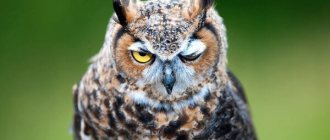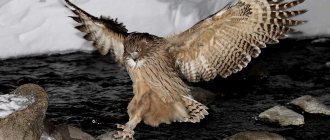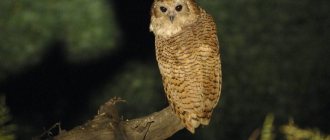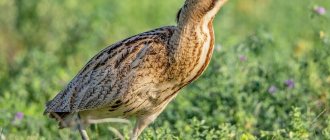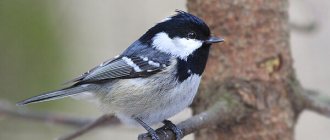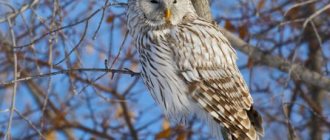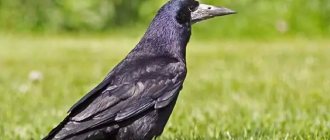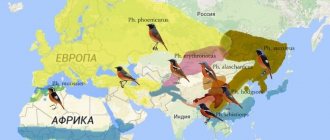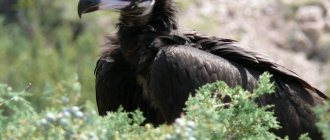- Wild animals
- >>
- Birds
We have all the eagle owl since childhood, because there are many fairy tales, nursery rhymes, and poems about him; he is the hero of various cartoons, personifying wisdom and nobility. This amazing bird looks slightly stern and serious, but very beautiful and elegant. Looking at the eagle owl, one cannot remain indifferent, because its appearance is so charming. Is he really as smart and gloomy as he seems at first glance?
Description, structure, characteristics
Eagle owls are close relatives of owls. Although this is not even true, according to the zoological classification they belong to the family of owls, the subfamily of true owls and the genus of eagle owls themselves. We can say that eagle owls are the largest representatives of the owl family, and the common eagle owl, in turn, is the largest of the eagle owls and owls. Its height reaches 75 cm in length, and its average weight is about 4 kg.
But the Fraser's eagle owl is the smallest eagle owl, measuring only up to 44 cm in length and not heavier than 815 grams.
An interesting fact: among eagle owls, like many insects, there is sexual dimorphism - females are larger and heavier than males.
The physique of eagle owls is dense and stocky, the body shape is barrel-like, it is believed that it is this way due to the thick and loose plumage that eagle owls have. The eagle owl's legs are short but strong, with long and tenacious black claws used for capturing potential prey.
The eagle owl's wings are powerful and long, and their owners are excellent flyers. The wingspan of the eagle owl is 1.8-1.9 m.
The eagle owl’s head is very large, wide, has a rounded shape, and also has additional tufts of feathers, which form what are called the eagle owl’s “signature” ears.
The beak of an eagle owl is usually short and strong, black in color; at its tip there is a special hook, with the help of which the bird makes special clicking sounds.
The eagle owl's plumage is thick and lush. Eagle owls are typically rusty brown or smoky gray in color. The head and chest are often decorated with dark teardrop-shaped spots.
The eagle owl's eyes are very large (one might even say huge), usually yellow, bright orange or red. The eyes themselves of these birds are well developed, moreover, eagle owls see perfectly from a greater distance, equally well, both at night and during the day. But they don’t distinguish colors at all; eagle owls’ vision is black and white.
In addition to good vision, eagle owls have even more excellent, acute hearing, which has a kind of acoustic filter that will allow the bird to filter only the necessary sounds.
Interesting fact: the special anatomical structure of the eagle owl’s head allows it to completely calmly rotate its head a full 200 degrees without fear of breaking its neck.
Popular message topics
- Lily of the valley in May
Lily of the valley is not only a beautiful and wonderful-smelling flower, it is also the first May plant that brings joy to everyone after the prolonged winter cold. Its flowers are quite delicate and in shape resemble small bells hanging on a stem. - Lena River
The Lena River is one of the most famous rivers in Russia. The length of the River is about 4 thousand kilometers. The location of the river is adjacent to the Baikal ridge. The Lena River is located in the Irkutsk region. And its tributaries carry water to Krasnoyarsk, - The work of field farmers
Field cultivation plays a huge role in agriculture. It goes well with other areas of plant growing. Field farming is responsible for growing cultivated plants and providing food for humans,
Difference from an owl
Although eagle owls and owls are close relatives, there are significant differences between them, which we will write about below.
Hunting
Eagle owls are excellent hunters; moreover, unlike owls, they are able to hunt equally successfully both day and night. Usually the hunting process for eagle owls goes like this: making short flights, they look out for potential prey and when such, to their grief, the owl catches the eye, it quickly rushes at the prey, piercing its body with its sharp claws.
Interesting fact: when hunting for fish, eagle owls can even dive into the water, diving for a while.
Small prey, field mice,
The eagle owl, as a rule, swallows lemmings and other rodents whole, but first tears larger game into pieces with its claws.
What does it eat?
— Advertising —
Eagle owl sitting by the sea photo
The eagle owl preys on various vertebrates, small mammals and birds. In general, the choice of food for birds is very wide. At the same time, the eagle owl easily switches from one food to another, choosing the most common animal species in a given territory. Thus, in Europe, the eagle owl’s diet includes gray rats, common and water voles, hedgehogs and wild rabbits. Sometimes the predator also catches fish, amphibians, reptiles and insects.
Food in captivity
In captivity, an adult eagle owl eats about 200-300 g of meat per day in the summer and from 300 to 400 g in the winter. Young birds eat more.
Features of hunting
The eagle owl is a nocturnal hunter; during daylight hours it flies out for prey only in winter or in bad weather. It hunts in open areas or forest edges. During the hunt, the bird flies briefly low above the surface of the earth or water, alternating fluttering flight with rest, during which it looks out for victims. Having noticed the prey, the eagle owl quickly rushes towards it and plunges its claws into it. Birds attack in the air. Dives for fish. Small prey is swallowed whole, and larger prey is divided into pieces.
Nutrition
The diet of an eagle owl largely depends on its species, for example, there are fish eagle owls that successfully hunt fish and crabs. Speaking about the diet of the common eagle owl, it is very diverse and includes rodents, hares, squirrels, marmots, snakes,
lizards, even turtles. The large common eagle owl may well attack such large animals as roe deer, wild boars, deer, badgers, mountain goats
Types, photos and names
Next we will describe the most interesting species of eagle owls in our opinion.
White Owl
At first, the white owl was identified by scientists as a separate species, but later
ornithologists, after consulting, decided to attribute the white owl to the genus of eagle owls. The polar owl is the largest representative of owls inhabiting the tundra; it reaches 70 cm in length and up to 3 kg in weight. The white color of these birds makes them almost invisible against the background of the northern winter landscape. The main food of the white owl is lemmings, these fluffy pilgrims, and the way of life, including that of the white owl, is largely associated with their famous migrations. Namely, in those years when many lemmings die due to migrations, snowy owls also stop reproducing due to the lack of food supply.
Fish owl
Its other name is the Far Eastern fish owl, which designates the habitat of this bird. The fish owl is also one of the largest members of the owl and eagle owl family, measuring 70 cm in length and weighing about 4 kg. Its main food is fish and other seafood. The nests of these eagle owls are usually located in hollows of old trees near water.
Common eagle owl
Also known as scarecrow. This is another large representative of the eagle owl kingdom, living over a wide geographical range from Europe to China. The common eagle owl usually lives in forests, but can live in the desert and mountains. It has many objects for hunting; according to zoologists, it feeds on only 300 species of birds and about 130 species of rodents; in general, these eagle owls have good gastronomic diversity.
Bengal eagle owl
The Bengal eagle owl is medium-sized, with an average body length of 50-56 cm and a weight of 1.1 kg. Its distinctive feature is the light color of the plumage, yellow-brown. It lives in Asian countries such as India, Pakistan, Nepal, Burma, and is under the protection of Indian authorities.
Great Eagle Owl
This species of eagle owl, living in America, was first discovered by white colonists in the territory of the modern state of Virginia, USA, for which it received its name. Its size is literally slightly inferior to the European eagle owl - its length reaches 63.5 cm. And this is the largest eagle owl in the American
continent. It also has a variety of plumage colors; it can be rusty brown, black, white, gray. The diet and lifestyle of the Great Eagle Owl is very similar to that of its European relatives.
African eagle owl
Also known as the spotted eagle owl. On the contrary, it is a very small representative of the kingdom of eagle owls, growing in length to only 45 cm. The plumage of this eagle owl is red-brown in color with white spots randomly scattered throughout the body. It lives, as its name suggests, on the African continent, in North Africa, but is also found on the Arabian Peninsula. Due to its small size, the main diet of this eagle owl is various large insects.
Gray owl
Also known as the Abyssinian eagle owl. Previously, they were considered a subspecies of the African eagle owl, but later ornithologists identified them as a separate species. They have a light brown or smoky color with dark spots on the chest. They live in Africa, south of the arid Sahara Desert.
Nepalese eagle owl
The Nepalese eagle owl, which lives in medium-sized Asian countries, its body length is about 51-61 cm. It has a grayish-brown color; it is interesting that younger individuals of the Nepalese eagle owl are lighter in color than older representatives. Also, a special distinctive feature of this type of eagle owl is its voice, it is very similar to a human one. This feature often frightens the local population, which is why this bird is even nicknamed “ulama,” which translates from Nepali as “devil bird.”
Natural enemies of the eagle owl
Photo: Eagle Owl
Surprisingly, the eagle owl can be considered the top of the food chain, which indicates that it has practically no enemies in the wild. This bird is quite powerful and large-sized, so other predators are in no hurry to attack the eagle owl. Only young animals can suffer from attacks by bears and wolves, but such cases are most likely considered an exception and occur extremely rarely.
Eagle owls are threatened by a wide variety of parasites that settle in dense plumage; various diseases and infections transmitted by the same parasites can lead to the death of the bird.
The most dangerous enemy of the eagle owl is humans, who cause damage to its population, both directly and indirectly. Even in recent times, people mistakenly believed that eagle owls were harmful to agricultural lands, so they massively destroyed these beautiful feathered creatures, as a result of which many species of eagle owls are now considered endangered.
Man harms birds by encroaching on their habitats, driving birds away from their permanent inhabited territories with his vigorous activity. Also, poisoning rodents with various pesticides destroys many birds that hunt them and quickly die after tasting a poisoned mouse carcass.
Reproduction
Sexual maturity in eagle owls is reached in the second or third year of life. And eagle owls are monogamous birds, creating strong families, which do not break up even after the mating season is over; a “loving” pair of eagle owls continues to live and hunt together.
The mating ritual of eagle owls begins with the search for a partner; the female, as a rule, calls the male with a special hoot. Then they ritually feed and kiss each other with their beaks (of course, “kissing” among eagle owls may be different from our understanding of this action).
Then eagle owls make nests in tree hollows; they can also occupy other people’s nests, depending on the species. After some time, the female begins to lay eggs, she does this at intervals of one or two days. Typically, a complete clutch of eagle owl eggs is 4-5 eggs.
Eagle owl eggs are round in shape and covered with a rough shell. The female incubates the eggs exclusively, while the male hunts for food for his family. After 32-35 days, small eagle owls hatch from the eggs. Little eagle owls are born blind and only gain sight on the fourth day of life.
The first days of life, little eagle owls are under the care and protection of their mother, who feeds and protects her cubs. After 5-7 weeks, eagle owl chicks are already able to make short flights, by the 8th week they can already confidently fly short distances, and after another month they become ready for adult and independent life.
Habitats
Eagle owls are found throughout Europe, Asia, Africa, North and South America. At the end of the 19th and beginning of the 20th centuries, the number of eagle owls decreased sharply. In Denmark, France, Germany, Benelux it is almost never found.
The eagle owl lives throughout Russia: in the European part, Siberian, in the Primorsky Territory, on the Amur.
Eagle owls are looking for a secluded, safe place to lay eggs.
Interesting Facts
- Eagle owls, like owls, are smart birds (it’s not for nothing that the owl was the personification of wisdom among the ancient Greeks); some of the habits of these birds speak of their high intelligence. For example, if an eagle owl's nest is in danger, it will circle around with its wings spread wide, thus appearing larger and scarier to its enemy.
- Since ancient times, eagle owls have been surrounded by various unkind human superstitions. For example, it was believed that an eagle owl sitting on the roof of a house foreshadows the imminent death of one of the household members. For the same reason, various sorcerers used the bones and skull of an eagle owl for magical rituals.
- According to scientists, an eagle owl is capable of hooting more than 100 times per night.
Lifestyle Features
The eagle owl moves within a radius of 15-80 km during its entire life if there is a sufficient amount of food in this territory. It is considered a nocturnal animal, as it is most active at dusk and sedentary during the day. Features of the feather cover that allow them to move silently, strong legs, sharp eyesight, good hearing, a unique way of obtaining food, a low voice - all these are signs of nocturnal animals.
Most species lead a sedentary lifestyle, and the inhabitants of the northern regions cannot survive the harsh winter and head south during the cold season to find sufficient food. They are classified as migratory birds.
Eagle owl is resting
Video
And at the end of the video, a story about our today's hero, the eagle owl.
Author: Pavel Chaika, editor-in-chief of Poznavaika magazine
When writing the article, I tried to make it as interesting, useful and high-quality as possible. I would be grateful for any feedback and constructive criticism in the form of comments on the article. You can also write your wish/question/suggestion to my email [email protected] or Facebook, with respect, the author.
Author page
Where does it live?
— Advertising —
Places on the map where the eagle owl lives
The eagle owl is distributed throughout Eurasia, from the western borders to Sakhalin, the southern Kuril Islands and the coast of the Sea of Okhotsk. In this region, the bird does not nest in the forest-tundra, tundra, as well as on the Indian subcontinent and Indochina peninsulas, in Britain, Ireland and on the islands of the Mediterranean Sea. In North Africa, eagle owls live in the south of the region.
In general, the eagle owl lives in various landscapes from taiga to deserts, but the bird needs secluded places for resting and breeding, for example, forested rocky slopes, scatterings of stones, hilly areas with ravines. In addition, eagle owls nest in swamps, river valleys, open forests, clearings, burnt areas and forest dumps. It does not live in continuous forests, but on the outskirts and edges, in groves next to open spaces, eagle owls are frequent guests. Eagle owls are also often found in the mountains at altitudes up to 4700 m above sea level. An important factor determining the habitat of a bird is the availability of food supply.
Eagle owls are not afraid of people, but usually live far from populated areas and roads. Only occasionally can you find this nocturnal predator on farms or in park areas of large cities.
